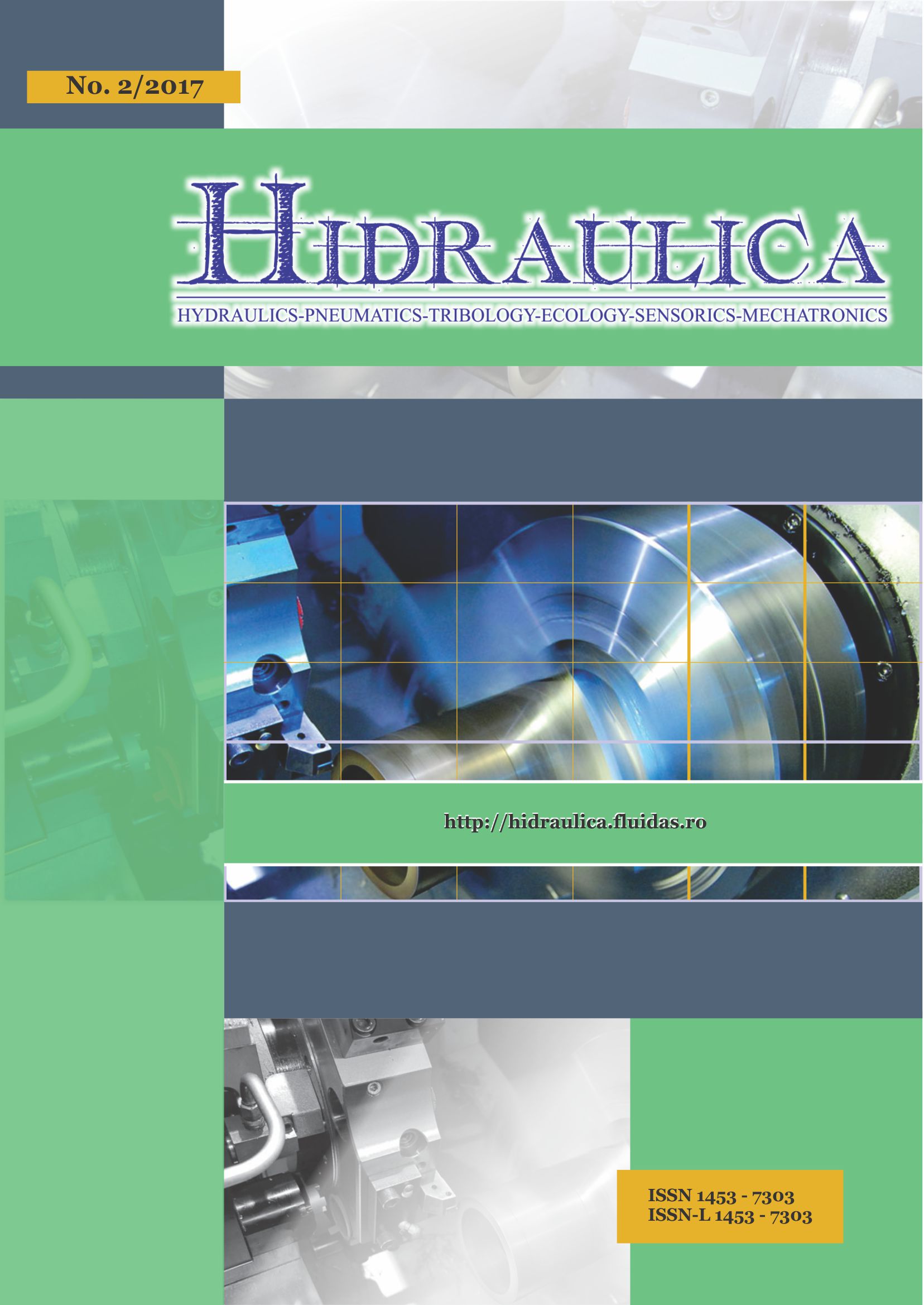Vector Estimation of Centrifugal Force and CAD Techniques for Protection Mechanism at Over-Speed of the Low-Power Wind Turbine Rotor
Authors: Teodor MILOȘ, Mircea BĂRGLĂZAN, Rodica BĂDĂRĂU
Rotor over-speed protection for small power wind turbine requires a possible cheap and reliable mechanical system. This is because any electric or electronic device depends on the electrical power source which by an electrical damage becomes unavailable. Between these protection devices centrifugal mechanism is priced at acceptable cost, but contains some subtleties of interpretation of the mode of operation. In this paper, it is explained step by step the original solution of this mechanism put in place for a 5 kW wind turbine. After triggering the centrifugal mechanism, the rotor blades are rotated to the flag position producing aerodynamic braking of the rotor. The speed is reduced to 20 … 30 rpm, after which … (read more)
Dynamics of Hydraulic Cylinders. Classical Mathematical Models and Simulations
Author: Anca BUCUREȘTEANU
This paper presents mathematical models in dynamic mode for the study of hydraulic cylinders. It analyses the influence of the distributor type used for cylinder actuation but also the necessary correlation of pump flow, cylinder features and adjustment of pressure valve. The paper has a practical character because some unwanted dynamic aspects, such as …. (read more)
Genetic Programming Applied for Shaping a Design Hydrograph from the Historical Flows’ Pattern
Authors: Maritza Liliana ARGANIS JUÁREZ, Juan José BAÑOS MARTÍNEZ,
Margarita PRECIADO JIMÉNEZ, Cecilia GONZÁLEZ CORREA
A method based on applying genetic programming (GP) in the ascending and the descending branch of a parameterized hydrograph is proposed in order to get a design hydrograph. Parameterization is done by considering peak flow, the peak time and the approximate time base estimated from the behavior of the annual maximum historical floods envelope and historical annual maximum floods envelope measured in the study site in the study site. With GP, was obtained the hydrograph’s behavior before and after the peak flow for the historical data. Additionally, was made comparison of the GP results with a polynomial interpolation of Lagrange. Afterwards a design hydrograph was obtained, for “El Infiernillo” dam, considering …. (read more)
Comparative Study of the AWJ Cutting Geometry using the 3D Point Measuring Method versus 3D Scanning of the Surfaces
Authors: Adrian Paul BASARMAN, Nicolae MEDAN
The abrasive waterjet cutting (AWJ) method is a modern and very a useful technology cause it uses a different technique of cutting the material, more different than the classic way of cuting in which a tool takes contact with the part that needs to be cut. In order to asses the surface resulted after cutting, the kerf width, the surface has to be analysed on both sides of the cut, both on the part and the counterpart. In this paper it is presented a comparative study on a C45 part cutted using AWJ and, the surface resulted is first measured using a 3D measuring arm that measured the surface in points per surface and, second, using a … (read more)
Examining the Characteristics of Pedrollo_CP130 Centrifugal Pump in Simulated Service Conditions
Author: Nikolett FECSER
In my study I examine the characteristics of a Pedrollo_CP130 centrifugal pump during operation. My choice of topic is justified by the facts that Pedrollo pumps have widely been applied, they are reliable and can be operated highly efficiently. Since their improper usage can cause problems, I decided to study the parameters of Pedrollo_CP130 pumps during operation to be able to avoid these problems. The fundamental characteristics of these pumps are flow rate, elevation head, power demand and efficiency. The monitoring of the pump’s characteristics is undertaken in the fluid dynamics laboratory in …. (read more)
Assessing the Hydro Power Potential of Bistrita River
Authors: Mariana PANAITESCU, Fanel-Viorel PANAITESCU
The aim of the paper is the study of the Bistrita River from the point of view of water. It proposes a linear representation of the specific synoptic potential and graphical representation of water cadastre. The calculation is done on each sector and it follows the steps: sector fall, average flow per sector, theoretical power sector, theoretical energy sector, sector length, specific theoretical linear potential of the k sector and …. (read more)
Optimizing the Equation of Impact Forces Produced by Water Jets Used in Sewer Cleaning
Authors: Nicolae MEDAN, Adrian Paul BASARMAN
The purpose of this paper is to optimize the equation of the impact forces produced by water jets used in sewer cleaning. The functioning of the cleaning sewer is dependent on certain process parameters, which can vary, causing variations of the impact forces. The research method used is Taguchi design of experiment. To be able to make the experiments there was used a stand to generate the water jets and a device to measure the impact forces. In the first part of paper was determined the percentage of influence of parameters involved in the process and then … (read more)
Maintaining Position of Servo Cylinders by Means of Digital Hydraulics
Authors: Ioan PAVEL, Bogdan TUDOR, Mihai Alexandru HRISTEA, Ana-Maria POPESCU
Replacing hydraulic proportional equipment and servovalves by simple-design systems in the area of digital hydraulics within positioning applications that use hydraulic cylinders is a solution that can lower the production price and …. (read more)
Possibilities for Agricultural Farms of Adopting and Applying Optimal Energy Recovery Solutions from Nearby Water Flows
Author: Fănel Dorel ȘCHEAUA
Today, must be highlighted the increase of energy needs according to continues population growths worldwide. That is why it should be increasingly used the possibilities of energy obtaining by optimizing the resources at hand. These clean resources that do not have a major impact on the environment, are represented by water falls and flows. These resources are among the most advantageous in terms of obtaining the electrical energy by converting the mechanical energy obtained by the flowing water from a river. A method of obtaining electric energy based on the water flow power is presented in this paper. It is about …. (read more)
